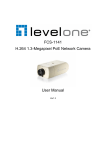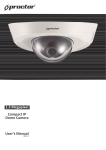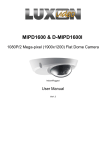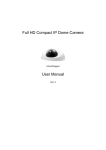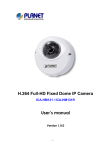Download 1.3 Megapixel IP Camera User Manual
Transcript
1.3 Megapixel IP Camera User Manual 00P3H060MZSEA1-01 Table of Contents 1. Overview .....................................................................................................................3 1.1 Features.............................................................................................................3 1.2 Package Contents..............................................................................................4 1.3 IP Surveillance System Architecture ..................................................................5 2. Introduction of IP Camera..........................................................................................6 2.1 Camera Dimensions ..........................................................................................6 2.2 Connectors on the Rear Board ..........................................................................6 3. Preparations for IP Camera Setup ............................................................................8 3.1 System Requirements........................................................................................8 3.2 IP Camera Installation........................................................................................8 3.3 Accessing IP Camera ......................................................................................10 4. IP Camera Configuration & Operation ....................................................................15 4.1 Browser-based Viewer Introduction .................................................................15 4.2 System Related Settings..................................................................................16 4.2.1 Host Name and System Time Setting................................................17 4.2.2 Security..............................................................................................17 4.2.3 Network .............................................................................................20 4.2.4 DDNS ................................................................................................23 4.2.5 Mail ....................................................................................................24 4.2.6 FTP....................................................................................................25 4.2.7 Application (Alarm Settings) ..............................................................25 4.2.8 View Log File .....................................................................................27 4.3 4.4 4.2.9 View Parameters ...............................................................................27 4.2.10 Factory Default ..................................................................................28 4.2.11 Software Version ...............................................................................29 4.2.12 Software Upgrade..............................................................................30 Video and Audio Streaming Settings ...............................................................34 4.3.1 Video Resolution and Rotate Type ....................................................34 4.3.2 Audio Mode and Bit Rate Settings .....................................................36 Camera Settings ..............................................................................................37 4.4.1 Exposure Setting ...............................................................................38 4.4.2 White Balance Setting .......................................................................38 4.4.3 Brightness Setting..............................................................................39 4.4.4 Sharpness Setting .............................................................................39 4.4.5 Contrast Setting .................................................................................40 4.4.6 Digital Zoom Setting ..........................................................................40 5. CMS Software Introduction......................................................................................41 Appendix A: Technical Specifications ...........................................................................42 1 Appendix B: Internet Security Settings .........................................................................43 Appendix C: Device Search Software ............................................................................45 2 1. Overview The IP Camera features a 1.3 Megapixel progressive scan CCD that delivers unparalleled image quality. Utilizing progressive scan CCD sensor, it produces images of rapid moving objects with minimum motion blurring. Dual streaming enables users to view both MJPEG images and MPEG-4 video to achieve superior image quality and conserve bandwidth. And with ultra high resolution of 700 TVL, users can monitor critical areas with greater detail like nothing before. 1.1 Features Image Quality • 1/3” Sony progressive scan CCD • 1.3 Megapixel high definition • Low light sensitivity 0.2 [email protected] Application • Dual streaming: MJPEG & MPEG-4 - MJPEG up to 1280x960 @15 fps - MPEG-4 up to 640x480 @ 30 fps • Digital zoom: 1x ~ 12x • Two-way audio • Image rotation: Flip, Mirror, and 180∘rotate • Free bundled CMS software Easy Installation • • Compact size & light weight Interface: 10/100 Ethernet with RJ-45 connector 3 1.2 Package Contents Please check the package contains the following items listed below. 1.3 Megapixel IP Camera Alarm I/O terminal block DC12V Power Adaptor (DC model only) CD (bundled software, documentation) 4 C/CS mount lens adaptor 1.3 IP Surveillance System Architecture The figure below illustrates the system architecture of the IP Camera. It is capable of MJPEG and MPEG-4 dual streaming for flexible application. 5 2. Introduction of IP Camera This chapter will provide the camera dimensions for reference before installation. Definition of each connector on the camera’s rear board will also be specified. 2.1 Camera Dimensions VIDEO DC The IP Camera’s dimensions are shown as below. DC12V NETWORK I/O 1 2 3 4 LINE OUT LINE IN MIC IN AUTO IRIS 2.2 Connectors on the Rear Board The diagram below shows the IP Camera’s rear board. Definition for each connector will be given as follows. Reset Button VIDEO DC Power LED DC12V NETWORK I/O 1 2 3 4 LINE OUT LINE IN MIC IN AUTO IRIS 6 Connector Definition Power LED Green link light indicates good power connection. Reset button For system reset Press and hold the Reset button to restore factory default settings. DC12V connector DC 12V power connection Video/DC switch For Video drive lens/DC drive lens. Set the switch to “Video” if use a video drive lens, and set it to “DC” when using a DC drive lens. I/O terminal connector For alarm connection (see section 3.2) Line Out & Line In / Mic In ports For two-way audio transmission Network connector RJ-45 connector for LAN connection Network LEDs Link and activity Green link light indicates good network connection Orange activity light flashes for network activity indication. Auto iris connector For use with auto iris lens 7 3. Preparations for IP Camera Setup This chapter outlines information about system requirements for IP Camera operation, procedures of camera connection, and login to the camera. 3.1 System Requirements To perform the IP Camera via web browser, please ensure your PC is in good network connection, and meet system requirement as described below. 3.2 Items Minimum Requirement Personal Pentium-III 600MHz processor Computer RAM 256 MB Operating System Windows 2003, XP Web Browser Microsoft Internet Explorer 6.0 or above Network Card 10Base-T (10 Mbps) or 100Base-TX (100 Mbps) operation Viewer ActiveX control plug-in for Microsoft IE IP Camera Installation Please follow the instructions below to complete IP Camera installation. Cable Connection Use of Category 5 Ethernet cable is recommended for network connection; to have best transmission quality, cable length shall not exceed 100 meters. • When connecting through a hub or switch: Connect one end of a straight through CAT5 cable to the RJ-45 connector of the IP camera, and the other end of the cable to the hub or switch. • When connecting to PC directly: Connect one end of a crossover CAT5 cable to the RJ-45 connector of the IP camera. Then connect the other end of the cable to PC. Power up the Camera Connect the power jack to the IP Camera before plugging in to power socket, to avoid danger of electric shock. 8 Check over the status of the link indicator and activity indicator LEDs; if the LED is unlit, please check LAN and power connection. Green link light indicates good network connection. Orange activity light flashes for network activity indication. Software Installation It is required to setup the software program “ipp41_runtime_installer”, to communicate the PC with IP Camera, and view live video. The program can be found in “Client program” folder in the supplied CD. Double click to execute the program; it will be automatically installed to your PC. The installation wizard shuts down when installation completed. Alarm Application The camera equips one relay input and one relay output for alarm application. Refer to alarm pin definition below to connect alarm devices to the IP Camera if needed. Output Spec.: • Open collector output 1 2 3 4 1. Output+ 2. Output- 3. Input+ 4. Input- • Absolute MAX Voltage: 5.5V with pull-up resistor • Recommended Voltage: 3V ~ 5V with pull-up resistor • Recommended Pull up resistor is 1.8k~100k Ω for TTL Level at 5V operation. 9 3.3 Accessing IP Camera To access and configure the IP Camera, users simply login through the Internet Explorer (IE). Before that, users should make sure that the PC is connected to the same network as the camera. Camera Default IP The IP Camera’s default IP address is: 192.168.0.250. Therefore, to access the IP camera for the first time, set the PC’s IP address as: IP Address: 192.168.0.XXX Subnet Mask: 255.255.255.0 Follow the procedure to set PC IP address. Step 1: Enter “Network Connections” on the “Control Panel” or “Network Neighborhood”, and double click “Local Area Connections.” Step 2: In the page “Network Connections,” double click “Local Area Connection.” 10 Step 3: Select “Internet Protocol (TCP/IP)” and click “Properties” to enter its sub-page. 11 Step 4: In the IP Address field, enter “192.168.0.XXX.” In the Subnet Mask field, enter “255.255.255.0.” Then Click “OK” to confirm the setting. NOTE: XXX can be the number between 1 and 255, except for 250. Additionally, if users want to change the IP address or the IP Camera to obtain the IP address automatically. Login ID & Password After setting the PC’s IP address, key in the IP Camera’s IP address: “192.168.0.250” in the URL bar and press “Enter”. Then the dialogue of request for entering default username and password (as shown below) will prompt for login the IP Camera. 12 The default login ID and password are like the following: Login ID Password Admin 1234 NOTE: The first letter of the default username should be capital. NOTE: It is strongly suggested that Administrator’s password be altered for the security concerns. Refer to section 4.2.2 Security for further details. Installing Plug-in For the initial access to the IP Camera, the web browser shall ask for permission to install a plug-in for display video in browser. Click on “Yes” to allow the installation. If web browser doesn’t allow the installation, check the Internet security settings (see Appendix B) and lower the security level to continue the process. Once login in is completed, users will see the Home page shown as below: 13 User Privilege “Administrator” represents the person who can configure the IP Camera and authorize user access to the camera; “user” refers to whoever has access to the camera with limited authority, i.e. entering Home and Camera setting pages. Image and Focus Adjustment The image displays on the Home page when successfully accessing to the IP Camera. Adjust the zoom and focus pullers on the lens as necessary to produce a clear image. 14 4. IP Camera Configuration & Operation The IP Camera is provided with a user-friendly browser-based configuration interface, and a free bundled CMS (Central Management System) for record and playback video. In this chapter, information about main page introduction, system related settings and camera settings will be described in detail. For further information about CMS software, please refer to Chapter 5 and CMS user manual. 4.1 Browser-based Viewer Introduction The figure below shows the main page of the IP Camera user interface. At the bottom of the main page, users can also adjust video size (x1, x1/2 and full screen) and select a kind of video format (MPEG-4 and JPEG). There are four tabs: Home, System, Streaming and Camera, on the top panel. Home Under the page, users can monitor live video of the targeted area. 15 System setting Under the item, Administrator can set host name, system time, root password, network related settings, etc. Further details will be interpreted in section 4.2 System Related Settings. Streaming setting The Administrator can adjust video resolution and rotate type and select an audio mode. Camera setting The user can adjust various camera parameters, including <EXPOSURE>, <WHITE BALANCE>, <BRIGHTNESS>, <SHARPNESS>, <CONTRAST> and <DIGITAL ZOOM>. 4.2 System Related Settings The figure below shows all categories under the “System” tab. Each category in the left column will be explained in the following sections. 16 4.2.1 Host Name and System Time Setting Press the first category: <System> in the left column; the page is shown as below. Host Name The name is for camera identification. If alarm function (see 4.2.7 Application) is enabled and is set to send alarm message by Mail/FTP, the host name entered here will display in the alarm message. Sync With Computer Time Select the item, and video date and time display will synchronize with the PC’s. Manual The Administrator can set video date, time and day manually. Entry format should be identical with that shown next to the enter field. 4.2.2 Security Click the category: <Security>, and the page is shown as the figure below. 17 Root password Change the Administrator’s password by inputting the new password in both text boxes. The input characters/numbers will be displayed as dots for security purposes. After clicking <Save>, the web browser will ask the Administrator for the new password for access. The maximum length of the password is 14 digits. NOTE: these characters are valid: A-Z, a-z, 0-9, !#$%&’-.@^_~ Add user Type the new user's name and password and click <Add> to add the new user. Both user name and password can be up to 16 characters. The new user will be displayed in the user name list. There is a maximum of twenty user accounts. Each user can be assigned four types of privileges – “I/O access”, “Camera control”, “Talk” and “Listen”. 18 • I/O access This function is disabled. • Camera control This item allows the appointed User to change camera parameters on the Camera Setting page. • Talk/Listen Talk and Listen functions allow the appointed user in the local site (PC site) communicating with, say, the administrator in the remote site. Manage User Delete user To delete a user, pull down the user list, and select the user name you wish to delete. Then click <Delete> to remove it. Edit user Pull down the user list and select a user name. Click <Edit> to edit the user’s password and privilege. When finished, click <Save> to modify the account authority. 19 4.2.3 Network Click <Network> in the left column, and the page will display as shown below. Users can choose to use fixed IP address or dynamic (DHCP) IP address. The following is descriptions for the two ways of setting IP address. Get IP address automatically (DHCP) The camera’s default setting is “Use fixed IP address”. Please refer to the previous section 3.3 Accessing IP Camera for login with the default IP address. If select “Get IP address automatically”, users will be requested to perform the installer program: DeviceSearch.exe, which can be found in “DeviceSearch” folder in the supplied CD, whenever the IP camera resets. NOTE: Please make the record of the IP Camera’s MAC address, which can be found in the label of the camera. Request for selecting a MAC address will occur during executing DeviceSearch. The procedure of employing DeviceSearch to login the IP Camera, please refer to Appendix C. 20 Use fixed IP address To setup static IP address, select “Use fixed IP address” and move the cursor to the IP address blank (as indicated below) and insert the new IP address, ex. 192.168.7.250; then go to the Default gateway (explained latter) blank and change the setting, ex. 192.168.7.254. Press “Save” to confirm the new setting. After setting the camera’s new IP address, please go to the PC’s TCP/IP setting (see 3.3 Accessing IP Camera) for resetting as well. The following is the descriptions for each TCP/IP related setting. • DHCP This item allows users to obtain a dynamic IP address from DHCP (Dynamic Host Configuration Protocol) server during camera boots up. When using DHCP, the settings are dynamic and they will change every time you power up and power off the camera, depending on your network's setup. If use DHCP, a dynamic IP will be assigned to the IP camera. In this case, users do not need to configure a static IP, and the Ethernet settings (IP address, Netmask, Gateway and DNS settings) will be read only. 21 • IP The item is used to configure the PC’s IP (Internet Protocol) address. The IP address is the identifier for your computer or device on a TCP/IP LAN or WAN. • Netmask A Netmask is a 32-bit mask used to divide an IP address into subnets and specify the networks available hosts. Its value is defined by your network administrator. It takes the form as ***.***.***.***, for example, 255.255.255.255. This item allows users to input the value of the Netmask for the PC. • Gateway Gateway is a node on a network that serves as an entrance to another network. • DNS DNS is the abbreviation for “Domain Name System”, which is an Internet service that translates domain names into IP addresses because domain names are easier to remember. General 22 • IP address This is necessary for network identification. • Subnet mask It is used to determine if the destination is in the same subnet. The default value is “255.255.255.0”. • Default router This is the gateway used to forward frames to destinations in different subnet. Invalid router setting will fail the transmission to destinations in different subnet. • Primary DNS Primary DNS is the primary domain name server that translates hostnames into IP addresses. • Secondary DNS Secondary DNS is a secondary domain name server that backups the primary DNS. HTTP • 4.2.4 HTTP port This can be other than the default port 80. Once the port is changed, the user must be notified the change for the connection to be successful. For instance, when the Administrator changes the HTTP port of the IP dome camera whose IP address is 192.168.0.100 from 80 to 8080, the user must type in the web browser “http://192.168.0.100:8080” instead of “http://192.168.0.100”. DDNS Dynamic Domain Name System (DDNS) allows a DNS name to be constantly synchronized with a dynamic IP address. In other words, it allows those using a dynamic IP address to be associated to a static domain name so others can connect to it by name. Enable DDNS Check the item to enable DDNS. 23 Provider Select one DDNS host from the provider list. Host name Enter the registered domain name in the field. Username/E-mail Enter the username or e-mail required by the DDNS provider for authentication. Password/Key Enter the password or key required by the DDNS provider for authentication. 4.2.5 Mail The Administrator can set as e-mail via Simple Mail Transfer Protocol (SMTP) when an alarm is triggered. SMTP is a protocol for sending e-mail messages between servers. SMTP is a relatively simple, text-based protocol, where one or more recipients of a message are specified and the message text is transferred. The configuration page is shown as follows: 24 Two sets of SMTP can be configured. Each set includes SMTP Server, Account Name, Password and E-mail Address settings. For SMTP server, contact your network service provider for more specific information. 4.2.6 FTP The Administrator can set as e-mail via File Transfer Protocol (FTP) when an alarm is triggered. The FTP setting page is shown below. Enter the FTP details, which include server, server port, user name, password and remote folder, in the fields. Press “Save” when 4.2.7 Application (Alarm Settings) The IP Camera equips one relay input and one relay output for cooperating with alarm system to catch events’ images. Refer to alarm pin definition below to connect alarm devices to the IP Camera if needed. The alarm configuration page is also shown below. 25 Output Spec.: • Open collector output 1 2 3 4 1. Output+ 2. Output- 3. Input+ 4. Input- • Absolute MAX Voltage: 5.5V with pull-up resistor • Recommended Voltage: 3V ~ 5V with pull-up resistor • Recommended Pull up resistor is 1.8k~100k Ω for TTL Level at 5V operation. Alarm Switch The Administrator can turn on or turn off the alarm function. Alarm Type Select an alarm type, “Normal close” or “Normal open,” that corresponds with the alarm application. Alarm Output Define alarm output signal “high” or “low” as the normal alarm output status according to the current alarm application. 26 Send Alarm Message by FTP/E-Mail The Administrator can specify whether to send the alarm message by FTP/E-mail when an event happens. 4.2.8 View Log File Click on the link to view the system log file. The content of the file provides useful information about configuration and connections after system boot-up. 4.2.9 View Parameters Click on this item to view the entire system’s parameter setting. 27 4.2.10 Factory Default The factory default setting page is shown as below. 28 Set Default Click on the “Set Default” button to recall the factory default settings. Then the system will restart in 30 seconds. Reboot Click on the “Reboot” button, and the system will restart without changing current settings. 4.2.11 Software Version The current software version is displayed in the software version page, which is shown as the figure below. 29 4.2.12 Software Upgrade Software upgrade can be carried out in the “Software Upgrade” page, as shown below. 30 NOTE: Make sure the upgrade software file is available before carrying out software upgrade. The procedure of software upgrade is like the following: Step 1: Type the IP Camera’s FTP address in the URL bar of the Web browser to login to the FTP site. The address is identical to the IP Camera’s IP address; the prefix ftp:// should be set before the address, ex. ftp://192.168.7.250. Then enter the User name and password, which are identical with the ones used when login to the IP Camera, to connect to the FTP site. Step 2: Copy the upgrade file, ex. userland.jffs2, from the source and paste it to the FTP site. 31 NOTE: Since it is allowed to upgrade one file at a time, please put only one upgrade file in the FTP site when executing software upgrade. Step 3: Go back to the IP Camera’s “Software upgrade” page. In the section: Step1, pull down the upgrade binary file list and select the one about to upgrade. 32 Step 4: Press “Upgrade” in the section: Step3. The system will then check whether the upgrade file exists or not. Then the upgrade status bar will display on the page. When it runs to 100%, the upgrade process is finished. Step 5: Close the Web browser and login to the IP Camera again. 33 4.3 Video and Audio Streaming Settings Press the tab ”Streaming” in the top of the page, and the two items: Video and Audio will display in the left column. The Administrator can configure specific video resolution, video rotate type, audio transmission mode and audio streaming here. Further details of these settings will be specified in the following sections. 4.3.1 Video Resolution and Rotate Type The video setting page is show as below: Video Resolution The IP Camera provides various video dual streaming formats like the following: • • • • Jpeg Quad VGA (15fps) + MP4 VGA (15fps) Jpeg VGA (30fps) + MP4 VGA (30fps) Jpeg VGA (30fps) + MP4 QVGA (30fps) Jpeg VGA (30fps) + MP4 CIF (30fps) • Jpeg VGA (30fps) + MP4 QCIF (30fps) Click “Save” to confirm the setting. 34 Video Rotate Type Users can change video display type if necessary. Selectable video rotate types include Normal, Flip, Mirror and 180 degree. Differences among these types are illustrated as below. Suppose the displayed image of IP camera is shown as the figure below. To rotate the image, users can select “Flip”, for instance. Then the displayed image will be reversed as shown below. The following is descriptions for different video rotate type. • Flip If select <Flip>, the image will be rotated vertically. • Mirror If select <Mirror>, the image will be rotated horizontally. • 180 Degree Selecting <180 Degree> will make the image inversed both vertically and horizontally. Click “Save” to confirm the setting. 35 4.3.2 Audio Mode and Bit Rate Settings The audio setting page is show as below. In the Audio page, the Administrator can select one transmission mode and audio bit rate. Transmission Mode • Full-duplex (Talk and Listen simultaneously) In the Full-duplex mode, the local and remote sites can communicate with each other simultaneously, i.e. both sites can speak and be heard at the same time. • Half-duplex (Talk or Listen, not at the same time) In the Half-duplex mode, the local/remote site can only talk or listen to the other site at a time. • Simplex (Talk only) In the Talk only Simplex mode, the local/remote site can only talk to the other site. 36 • Simplex (Listen only) In the Listen only Simplex mode, the local/remote site can only listen to the other site. • Disable Select the item to turn off the audio transmission function. Bit Rate Selectable audio transmission bit rate include 16 kbps, 24 kbps, 32 kbps, 40 kbps, uLAW and ALAW. Both uLAW and ALAW signify 64 kbps but in different compression formats. Higher bit rate will let higher audio quality and require bigger bandwidth. 4.4 Camera Settings The figure below is the Camera configuration page. Details of each parameter setting are described as follows. 37 4.4.1 Exposure Setting The exposure is the amount of light received by the image sensor and is determined by the width of lens diaphragm opening (iris adjustment), the amount of exposure by the sensor (shutter speed) and other exposure parameters. With this item, users can define how the Auto Exposure function works. Two modes, Auto Mode and Manual Mode, are available. Auto Mode In this mode, the camera’s Brightness, Shutter Speed, IRIS and AGC (Auto Gain Control) control circuits work together automatically to get consistent video output level. Manual Mode In this mode, users can select a number between 1 and 11, which represents shutter speed ranging from 1/4 to 1/10000 sec; bigger number means slower shutter. Once change the setting, press <SET> to confirm the new setting. 4.4.2 White Balance Setting A digital camera needs to find reference color temperature, which is a way of measuring the quality of a light source, for calculating all the other colors. The unit for measuring this ratio is in degree Kelvin (K). Users can select one of the White Balance Control modes according to the operating environment. The following table shows the color temperature of some light sources. 38 Light Sources Color Temperature in K Cloudy Sky Noon Sun and Clear Sky Household Lighting 75-watt Bulb Candle Flame 6,000 to 8,000 6,500 2,500 to 3,000 2,820 1,200 to 1,500 Auto Mode In this mode, white balance works within its color temperature range and calculates the best-fit white balance. Indoor/outdoor Mode Select for indoor or outdoor mode. Manual Mode In this mode, users can change the White Balance value manually. Users can select a number between 1 ~ 11, and press <SET> to confirm the new setting. 4.4.3 Brightness Setting Users can adjust the image’s brightness by adjusting the item. To increase video brightness, select a bigger number. Press <SET> to confirm the new setting. 4.4.4 Sharpness Setting Increasing the sharpness level can make the image looked sharper; especially enhance the object’s edge. Press <SET> to confirm the new setting. 39 4.4.5 Contrast Setting Camera image contrast level is adjustable; please select ranging from 1 to 11. 4.4.6 Digital Zoom Setting The camera’s digital zoom is adjustable from x1 to x12 at VGA resolution. Press <SET> to confirm the new setting. 40 5. CMS Software Introduction Central Management System (CMS) offers a powerful interface for a simple and centralized monitoring solution of your video surveillance equipments. It gives the user access to monitor multiple IP cameras and DVRs, and allows the user to simultaneously monitor 64 sites per group (up to 10 groups) within several clicks. One administrator and up to 3 users (depends on the product you bought) are allowed to access the remote DVR unit simultaneously through the CMS. Please find CMS software and its user manual in folder “CMS software” in the attached CD. 41 Appendix A: Technical Specifications Camera Image Sensor ⅓" Sony progressive CCD Picture Elements 1280(H) x 960 (V), 1.3M CCD Resolution >700 TVL Minimum Illumination 0.2 lux @ F1.2 Shutter Speed 1/4 ~ 1/10000 sec. White Balance Manual / ATW (1500 ~ 15000K) Lens Video drive & DC drive (selectable) Operation Video Compression MPEG-4 / MJPEG Video Streaming Simultaneous MPEG-4 and MJPEG video stream (dual stream) Resolution MPEG-4: VGA, QVGA, CIF, QCIF MJPEG: 1280x960(4 VGA), VGA Frame Rate Image Setting MPEG-4 30fps@VGA, MJPEG 15fps@1280x960 Brightness Manual Exposure Auto / Manual Sharpness Manual Contrast Manual White Balance Auto / Manual / Indoor / Outdoor Digital Zoom 1x ~ 12x Rotation Flip, Mirror, and 180∘Rotate Audio Line out, Line in/mic in Alarm 1 Relay In, 1 Relay Out Network Interface 10/100 Ethernet (RJ-45) Protocol IP, TCP, UDP, ICMP, FTP, SMTP, DHCP, HTTP, Telnet and IGMP Password Levels User and Administrator Internet Browser Internet Explorer (6.0+) User Account 20 Mechanical Lens Mounting Connectors C or CS Mount Power DC Jack Ethernet RJ-45 Audio Stereo phone jack, ∅ 3.5mm Alarm 4 pins terminal block, pitch 3.5mm Video drive & DC drive Auto Iris LED Indicator Power, Link, ACT General Operating Temperature 0°C ~ 50°C Humidity: 10% to 90%, no condensation Power Source DC12V Power Consumption 4.2W (max. 350mA@DC12V) Certificate Dimension CE, FCC, RoHS compliant 125 x 70 x 52 mm (L x W x H) (w/o lens) 42 Appendix B: Internet Security Settings Please follow the steps below to set the Internet security settings appropriately. Step 1: Start the Internet Explorer (IE). NOTE: Windows IE provides the ActiveX component that is required when using the programs mentioned above. Step 2: Select <Tools> from the main menu of the browser, then <Internet Options>, and then click the <Security> tab. Step 3: Select <Trusted sites> and click <Custom Level> in the Security Level area. The Security Settings screen is displayed as below: 43 Step 4: Under “All ActiveX controls and plug-ins”, set all items to <Enable> or <Prompt>. NOTE: If all ActiveX controls and plug-ins items are set to <Enable>, the web browser will permit the user to login in the Home page directly without any request. If these items are set to <Prompt>, several prompts of request for accepting ActiveX controls and plug-ins shall appear during login in. Step 5: Click <OK> to accept the settings and close the <Security> screen. Step 6: Click <OK> to close the Internet Options screen. 44 Appendix C: Device Search Software The procedure of employing DeviceSearch to login the IP Camera is like the following: Step 1: Select “Get IP address automatically, and the message of system restart will display in the page. Step 2: Double click on the program Device Search.exe (see the icon below); its window will appear as below. Step 3: Press the button “Device Search”, as shown in the figure above. Then all IP devices in the network will be listed in the zone down the Device Search button. 45 Step 4: Check the IP Camera’s MAC address; then select the IP address followed with the designate MAC. Double click or right click and select “Browse” to connect with the camera directly via web browser. Step 5: The dialogue of requesting for entering User name and Password should pop out. Enter the correct user name and password to login in the IP Camera. 46


















































